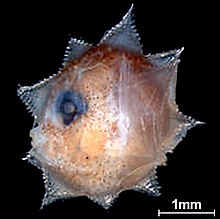Sunfish
| Sunfish | ||||||||||||
|---|---|---|---|---|---|---|---|---|---|---|---|---|

Sunfish ( Mola mola ) |
||||||||||||
| Systematics | ||||||||||||
|
||||||||||||
| Scientific name | ||||||||||||
| Molidae | ||||||||||||
| Bonaparte , 1832 |
The sunfish (Molidae), also Klump fish called, are a family in the order of pufferfish relatives (Tetraodontiformes). There are five known species, which are assigned to three genera.
Sunfish are found in the temperate and tropical zones of the Atlantic , Pacific, and Indian Oceans .
features
Sunfish grow up to 3.3 meters long and the largest species can weigh over a ton. They have a laterally flattened, disc-shaped or oval shape. Sunfish are gray on the top, silvery brown-gray on the sides and brightly colored below. Their skin is leathery and thick and contains small scales that touch on the basal plates and are covered by a cartilaginous tissue. The scientific name of the sunfish ( Mola mola ) refers to this appearance (large, round, gray, with a rough surface) : Latin mola means "millstone".
The dorsal and anal fins face each other symmetrically and serve as powerful main driving organs, they are short but high, without fin rays and are supported by cartilage plates. A caudal stalk and an actual caudal fin are missing. Instead, the body, which is blunt at the back, is lined with a leathery pseudocaudale formed from elements of the dorsal and anal fin. The pectoral fins are small. Ventral fins are missing, as is a lateral line organ .
A swim bladder and otoliths are not available. The heavily cartilaginous skeleton provides buoyancy. The number of vertebrae is 16 to 18. The gills sit on cartilaginous arches, the gill openings are small and lie directly in front of the attachment of the pectoral fins. In the heart, sunfish have four valves between the atrium and the heart chamber (ventricle). They have two tiny outer nostrils on each side of the head. The mouth is small and terminal and resembles a turtle's bill . There are only two teeth that have grown together in each jaw.
The larvae and fry are prickly.
Way of life
Sunfish live far from the coast in the open sea ( pelagic ) at a depth of up to 400 meters. They are slow swimmers and feed mainly on jellyfish , as well as plankton, algae, crustaceans and fish. The largest species, mola mola, can shed up to 300 million eggs.
species
| genus | Scientific name | Common name | IUCN status | distribution | |
|---|---|---|---|---|---|
| Masturus |

|
Masturus lanceolatus ( Liénard , 1840) |
Pointed tail sunfish |
|
Possibly worldwide in tropical and temperate seas. |
| Mola |

|
Mola alexandrini ( Ranzani , 1839) |
- | Possibly worldwide in tropical and temperate seas. | |

|
Mola mola ( Linnaeus , 1758) |
Sunfish |
|
Worldwide in tropical and temperate seas. | |

|
Mola tecta Nyegaard, Sawai, Gemmell, Gillum, Loneragan, Yamanoue, Stewart, 2017 |
- | Temperate marine areas in the southern hemisphere. | ||
| Ranzania |

|
Ranzania laevis ( Pennant , 1776) |
Slender sunfish | - | In the western and eastern Atlantic and the eastern Pacific. |
literature
- Joseph S. Nelson : Fishes of the World . John Wiley & Sons, 2006, ISBN 0-471-25031-7 .
- Kurt Fiedler: Textbook of Special Zoology, Volume II, Part 2: Fish . Gustav Fischer Verlag Jena, 1991, ISBN 3-334-00339-6 .
Individual evidence
- ↑ Masturus lanceolatus on Fishbase.org (English)
- ↑ Masturus lanceolatus at the IUCN (English)
- ↑ Mola alexandrini on Fishbase.org (English)
- ↑ Mola mola on Fishbase.org (English)
- ↑ Mola mola at the IUCN (English)
- ↑ Marianne Nyegaard, Etsuro Sawai, Neil Gemmell, Joanne Gillum, Neil R. Loneragan, Yusuke Yamanoue, Andrew L. Stewart: Hiding in broad daylight: molecular and morphological data reveal a new ocean sunfish species (Tetraodontiformes: Molidae) that has eluded recognition . Zoological Journal of the Linnean Society, July 2017, DOI: 10.1093 / zoolinnean / zlx040
- ↑ Mola tecta on Fishbase.org (English)
- ↑ Ranzania laevis on Fishbase.org (English)
Web links
- Sunfish on Fishbase.org (English)
